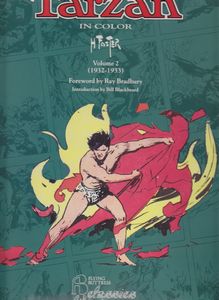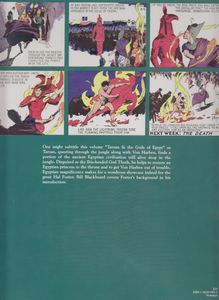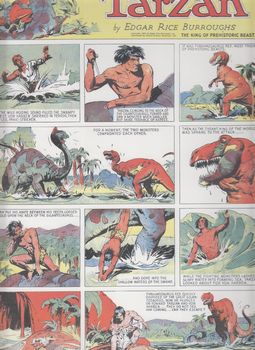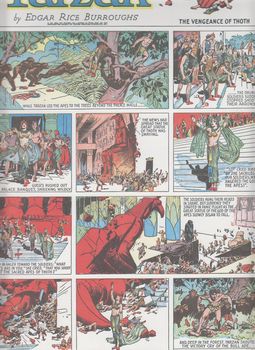volume 2 1932-1933
| série: | Tarzan Sunday Pages |
| dessinateur / scénariste: | Foster Harold |
| éditeur: | Flying Buttress EO 1993 |
| genre: | Aventure |
| classement: | biblio1 |
| date: | 1993 |
| format: | cartonné avec jaquette |
| état: | TBE |
| valeur: | 30 € |
| critère: | *** |
| remarques: | second volume edited by NBM/Flying Buttress (NBM being America's first publisher of graphic novels since 1976, located at New York with imprints such as Flying Buttress Classics Library, Amerotica, Eurotica and ComicsLit) under the supervision of Bill Blackbeard out of a sery of 18 volumes, all being accurate reproduction of the Sunday Pages in their full colour and in full size, each volume has about 52 pages, n.b. the sources of these Sunday pages are mainly from the Los Angeles Times and from the Milwaukee Journal edited by UFS (United Features Syndicate) volume 2 1932-1933 with dust jacket from 25.9.1932 (81) to 17.9.1933 (132) = 52 pages drawn by Hal Foster based on the novel of Edgar Rice Burroughs one might subtitle this volume "Tarzan and the Gods of Egypt" as Tarzan, questing through the jungle along with van Harben, finds a portion of the ancient Egyptian civilization still alive deep in the jungle; disguised as the Ibis-headed God Thoth, he helps to restore an Egyptian princess to the throne and to get van Harben out of trouble; Egyptian magnificence makes for a wonderous showcase indeed for the great Hal Foster, Bill Blackbeard covers Foster's background in his introduction the volume includes following episodes (number of pages): - into the Primeval Swamp part 2: 8 the Egyptian saga, part one: - the Monkey-Man: 16 - wrath of the Gods: 11 - children of the Sun God: 15 - Kamur the monster part one: 2 1/ preface by Ray Bradbury and notes by Bill Blackbeard a) at the beginning Foster was not especially interested to draw Tarzan (he considered comic strip as a low level creative expression) and let Rex Maxon start the first strips (1929-1931), but in view of the low quality of Maxon's strips and of course also in view of financial prospects during the recession period, he agreed to take over; notes about Edwin Porges who wrote a book to study Burrough's career with the title "the man who created Tarzan" during the great depression, comics were profitable business and Tarzan's strips caused an economical boom for advertisements in newspapers and Tarzan's strips had a great success as they were original, interesting and cheap! b) study about the continuation of a comic strip by other artists the work of other artists replacing the strips' originators was usually mostly disastrous, the example of Tarzan's strips being an exceptional acknowledged masterpiece during their continuation, Tarzan's strips drawn by Foster were valued much better than those of Prince Valiant's printed separately by Foster c) analysis about last pages of volume 1 and first pages of volume 2 (into the primeval swamp) and also about the change of colour between the white and the yellow Egyptian men, then returning white on 19.2.1933 d) the first pages of this volume give a good example of a "page chute or page fall" with the last panel for maintaining the suspense in the next page 2/ the story (the Egyptian saga, part one) in the primeval swamp and the swampy forest, fight with the gigantosaurus and the tyrannosaurus (inspired of course by Doyle's lost world) as well as with a stream of crocodiles and a black panther >> p. 16-10 the gigantosaurus and the savage tyrannosaurus >> p. 23-10 the savage-haired Tarzan Tarzan is helped by a mysterious little white (then yellow) monkey-man and afterward confronted by old Egyptian soldiers, Tarzan and van Harben are captured by them and brought to the Egyptian city, fight with the sacred apes of which Tarzan become the king, meeting with princess Nikotris, daughter of pharaoh and with Tutamken, the eccentric son of pharaoh being the little monkey-man because he was raised among apes (somehow like Tarzan), contested by the Egyptian high priests, Tarzan must prove his kinship with the beasts by swimming among the sacred crocodiles >> p. 20-11 the little monkey-man as swift as Tarzan >> p. 25-12 van Harben after his capture is shown practically naked >> p. up to 15-1-1933 the white Egyptians >> p. from 22-1-1933 the yellow Egyptians (as for Tarzan) >> p. 5-2- the sacred golden Egyptian beetle >> p. 12-2- Tarzan fits himself with crocodile's skin to swim among them (Tarzan becomes a crocodile-man) >> p. from 19-2-1933 Egyptians are white again Tarzan leaves the Egyptian city but princess Nikotris on search for Tarzan is captured by a giant-ape, then saved by Tarzan who is now retaken prisoner by the Egyptians who want to make him their God, Tarzan escapes again but for retaliation, the Egyptians get van Harben to be sacrificed to their god Moloch-Bal, Tarzan comes back to save van Harben, struggle of Tarzan with the Egyptian high priests, Tarzan disguises himself as the Ibis-headed God Thoth (see book cover) Nikotris becomes jealous of Tarzan and afterward is captured by a mysterious black monster, Tarzan goes on the trail of his ravisher (end of part one of the Egyptian saga) >> p. 2 up to 9-4-33 acrobatism through the air by Tarzan with a rather sensuous Nikotris >> p. 4-6-33 is Moloch-Bal really an Egyptian god? >> p. 10-9-33 last page with van Harben who is leaving with his beloved >> p. 17-9-33 the mysterious black monster n.b. in this first volume, Tarzan still wears half a cloth, but from volume 2 on he will now wear only a loin cloth after his arm has recovered well again (the part of the body on both sides of the spine between the lowest (false) ribs and the hipbones), meanwhile he has also dropped his necklace and hair band >> a very good volume, this Egyptian saga is abit naive, but still of quite good interest with dynamic and dramatic development and a super graphic art, especially during the first half of the book, the second part being not as good in quality drawing (change of newspapers?) but nevertheless this second volume shows a high quality in Forster's art of drawing |
| couvertures: |     |
Copyright 2008 - 2025 G. Rudolf
